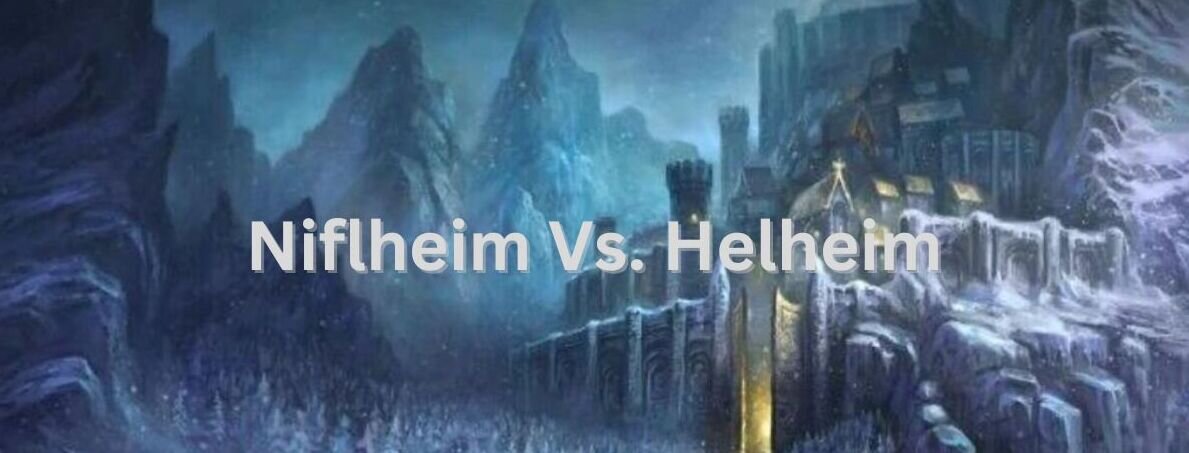Norse mythology dictates nine realms sit in the branches or the roots of Yggdrasil, the world tree. Of these nine, six are constant and feature in every image or description of the realms: Asgard, Alfheim, Vanaheim, Midgard, Jotunheim, and Muspelheim. The other three are a selection of Svartalfheim and Niðavellir or Hel and Niflheim. Svartalfheim and Niðavellir are sometimes combined, as are Hel (Helheim) and Niflheim.
This article attempts to unravel some of the mysteries associated with Hel and Niflheim and why they are sometimes confused.
What are the Etymologies of Niflheim and Helheim?
Niflheim
In Old Norse cosmology, Niflheim or Niflheimr means “World” or “Home of Mist.”
The Islandic word for“mist” is nifl and is a linguistic cognate to the Old English word nifol (“dark” or “gloomy”), the Middle Dutch nevel, the Old High German nebul (“fog”), and the Ancient Greek νεφέλη (“cloud”).
Hel or Helheim
The word “Hel” has cognates in every branch of the Germanic language, including hell in Old and Modern English, hellia in Old Saxon, and hella in Old High German.
The ultimate derivation of the word is the o-grade form of the Proto-Indo-European root kel (“to cover” or “conceal”). This derivation provides the reconstructed Proto-Germanic feminine noun haljō (“concealed place” or “underworld”).
The term is related to hall in Modern English and Valhalla, the afterlife “hall of the slain” in Norse Mythology. Hall and its cognates derive from the Proto-Germanic word hallō (or “covered hall” from the Proto-Indo-European kol.
What are the Characteristics of Niflheim?
In Norse mythology, Niflheim was the freezing, dark, and misty world of the dead, ruled over by the goddess Hel. Niflheim and Muspelheim originate from Ginnungagap (the “yawning void” or “gaping abyss”).
Any search for the ruler of Niflheim only produces the name Hel so there is no obvious answer to who the ruler was, which might hint the two realms are the same.
Vafthrúdnismál, the third poem of the Poetic Edda, tells how the rivers of Ginnungagap that existed there at the beginning of the world were called the Élivágar (Old Norse: “Ice Waves”). They contained eitr (described as poisonous yeast), a liquid that is the source of all living things. The frozen water broke the banks of the rivers and spread over the land.
There is a contradiction here: the verses also mention rain, which is strange for such a cold place, but we will have to put that down to artistic license on Sturluson’s part!
The poisonous ice extended towards the lands and fire giants of Muspelheim, started melting and dripping, and formed Ymir, the first frost giant.
What are the Characteristics of Helheim?
Helheim was the land of the afterlife for those who died of natural causes in Norse mythology. Valhalla, in turn, was the land of warriors who met a glorious end in battle. It lay at the bottom of the world in or near Niflheim.
Odin appointed Hel, the daughter of Loki, as its ruler.
The Poetic Edda describes how Brunhilde travels to Hel after committing suicide (or is killed; the sources differ) over the death of her love Siegfried. Odin rides to Hel on his eight-legged Sleipnir.
The Prose Edda tells the story of the retrieval of Odin’s son Baldr by his brother Hermóðr, who used Sleipnir to help him.
Are Helheim and Niflheim the Same Land?
There is no clear answer to this question in any of the literature available. We can only use translated sections of literature or poetry to try and gain some insight.
There are five critical mentions of the two lands in the Gylfaginning, the first part of Sturluson’s Prose Edda:
First Mention
In the first one, Odin (disguised as three men) tells Gylfi, an ancient Scandinavian king, that Niflheim was the first world to exist.
It was many ages before the earth was shaped that Niflheim was made; and midmost within it lies the well that is called Hvergelmir, from which spring the rivers called Svöl, Gunnthrá, Fjörm, Fimbulthul, Slíðr and Hríð, Sylgr and Ylgr, Víd, Leiptr; Gjǫll is hard by Hel-gates.
Niflheim – New World Encyclopedia
The final few words are significant here, with Odin not naming Hel as an independent place in the same way he describes Niflheim.
He describes a feature – the Hel-gates – but not a land in the same way he does Niflheim. The river Gjǫll marks the boundary between the dead and the living in Norse mythology.
Second Mention
In the second passage, Odin mentions how he sent Hel to Niflheim (not Helheim).
Hel he cast into Niflheim and gave to her power over nine worlds, to apportion all abodes among those that were sent to her: that is, men dead of sickness or of old age. She has great possessions there; her walls are exceeding high and her gates great.
Hel – Pantheon Org
Third Mention
The third account may give us some indication of Helheim’s location:
Now that the Æsir saw surely that the hill-giant was come thither, they did not regard their oaths reverently, but called on Thor, who came as quickly. And straightway the hammer Mjöllnir was raised aloft; he paid the wright’s wage, and not with the sun and the moon.
Nay, he even denied him dwelling in Jötunheim, and struck but the one first blow, so that his skull was burst into small crumbs, and sent him down below under Niflheim.
The Æsir broke their oath to the fortification builder – Voluspa Org
So, this third sentence would hint at Helheim lying further south of Niflheim and that it was a different place.
However, if it were, you would expect the text to name it rather than simply using Niflheim as a reference for where it was.
Fourth Mention
Perhaps the most conclusive evidence for Hel lying within Niflheim is Chapter 3.
Thridi is talking to Jafnhárr and Gangleri, saying:
But evil men go to Hel and thence down to the Misty Hel; and that is down in the ninth world.
Gylfagining – The Beguiling of Gylfi – Missouri State Edu
Not that Hel is the ninth world, but it lies within it.
Fifth and final mention
Then in chapter 34, Sturluson writes the following:
Hel he cast into Niflheim and gave to her power over nine worlds.
Niflheim – Mythopedia
Again, there is a preference for mentioning Niflheim as a place over no mention of Hel.
Attestations in the Poetic Edda
The Poetic Edda mentions Hel but not Niflheim. The references are only anecdotes and don’t give further information about the divide between the two.
In stanza 31 of Grímnismál, Hel lies underneath one of the three roots of Yggdrasil. The other two lead to Jotunheim and Midgard (somewhat confusingly, as Midgard is always depicted higher in the tree with a direct connection – the Bifrost – to Asgard.
There is the mention of Brunhilde’s journey to Hel and how she encounters a giantess lying dead in a grave meant for Brunhilde. Odin investigates the significance of his son Baldr’s nightmares and reanimates a völva (a female soothsayer). He forces her to divulge information about Ragnarök.
Conclusion
So much vague and conflicting evidence makes it difficult to draw a clear conclusion, but, taking the Prose Edda entries into account, it is difficult to deny that Hel is most likely a place within Niflheim.

